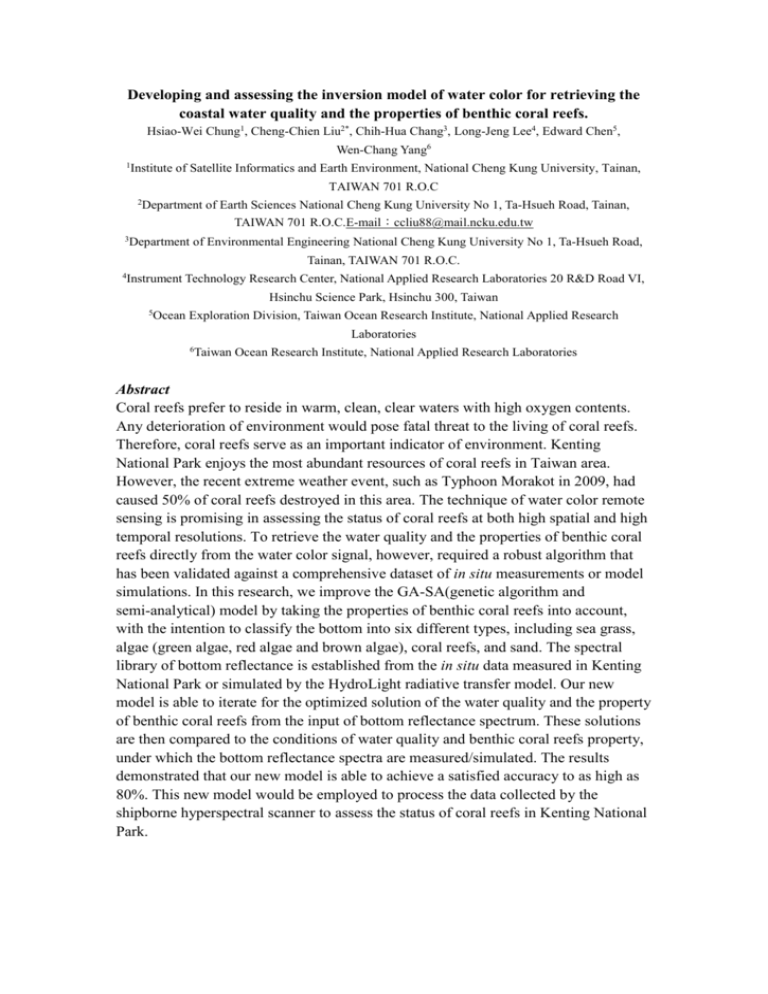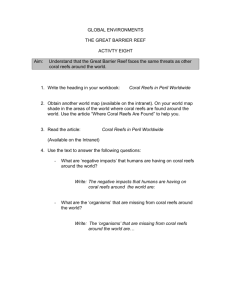Sample abstract (top): Single Affiliation
advertisement

Developing and assessing the inversion model of water color for retrieving the coastal water quality and the properties of benthic coral reefs. Hsiao-Wei Chung1, Cheng-Chien Liu2*, Chih-Hua Chang3, Long-Jeng Lee4, Edward Chen5, Wen-Chang Yang6 1 Institute of Satellite Informatics and Earth Environment, National Cheng Kung University, Tainan, TAIWAN 701 R.O.C 2 Department of Earth Sciences National Cheng Kung University No 1, Ta-Hsueh Road, Tainan, TAIWAN 701 R.O.C.E-mail:ccliu88@mail.ncku.edu.tw 3 Department of Environmental Engineering National Cheng Kung University No 1, Ta-Hsueh Road, Tainan, TAIWAN 701 R.O.C. 4 Instrument Technology Research Center, National Applied Research Laboratories 20 R&D Road VI, Hsinchu Science Park, Hsinchu 300, Taiwan 5 Ocean Exploration Division, Taiwan Ocean Research Institute, National Applied Research Laboratories 6 Taiwan Ocean Research Institute, National Applied Research Laboratories Abstract Coral reefs prefer to reside in warm, clean, clear waters with high oxygen contents. Any deterioration of environment would pose fatal threat to the living of coral reefs. Therefore, coral reefs serve as an important indicator of environment. Kenting National Park enjoys the most abundant resources of coral reefs in Taiwan area. However, the recent extreme weather event, such as Typhoon Morakot in 2009, had caused 50% of coral reefs destroyed in this area. The technique of water color remote sensing is promising in assessing the status of coral reefs at both high spatial and high temporal resolutions. To retrieve the water quality and the properties of benthic coral reefs directly from the water color signal, however, required a robust algorithm that has been validated against a comprehensive dataset of in situ measurements or model simulations. In this research, we improve the GA-SA(genetic algorithm and semi-analytical) model by taking the properties of benthic coral reefs into account, with the intention to classify the bottom into six different types, including sea grass, algae (green algae, red algae and brown algae), coral reefs, and sand. The spectral library of bottom reflectance is established from the in situ data measured in Kenting National Park or simulated by the HydroLight radiative transfer model. Our new model is able to iterate for the optimized solution of the water quality and the property of benthic coral reefs from the input of bottom reflectance spectrum. These solutions are then compared to the conditions of water quality and benthic coral reefs property, under which the bottom reflectance spectra are measured/simulated. The results demonstrated that our new model is able to achieve a satisfied accuracy to as high as 80%. This new model would be employed to process the data collected by the shipborne hyperspectral scanner to assess the status of coral reefs in Kenting National Park.






